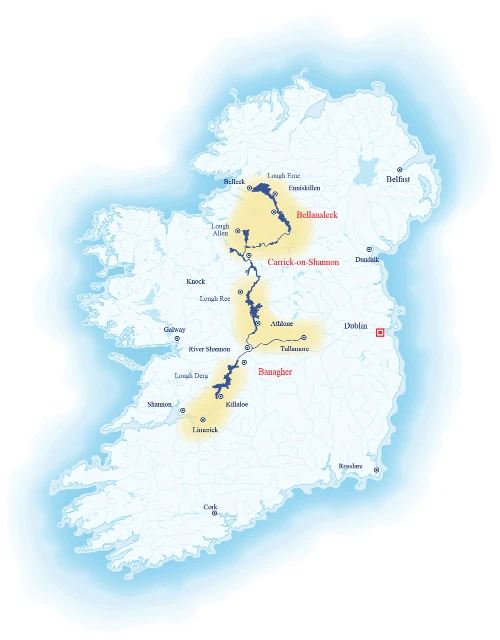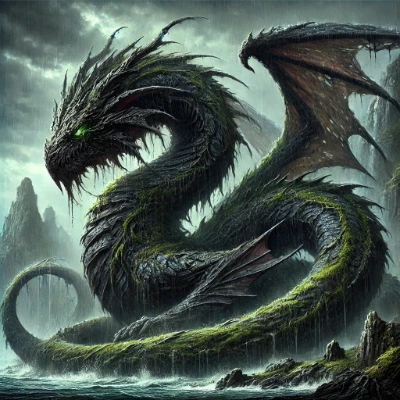How a Mysterious Serpent Allegedly Shaped the Shannon—and Captured Irish Imagination
The Oilliphéist
Ireland brims with legends of fantastical creatures lurking in its mists and waterways. While tales of the Dobhar-chú or the merrows capture our imaginations, one fearsome beast looms large in Irish folklore: the Oilliphéist. A serpent—or dragon-like creature—said to have carved the River Shannon itself, the Oilliphéist stands as a symbol of Ireland’s ancient, pagan past and a dramatic testament to the power of early Christian saints.
In this blog post, we’ll journey through this mighty monster’s history and cultural significance and discover why its story endures in Irish tradition.
Table of Contents
Origins of the Name
The name “Oilliphéist” can appear in various forms—Ollphéist, Oiliphéist, or Oillipheist. Still, at its core, it conveys “great beast” or “giant serpent.” In the Irish language:
- Oll = “great” or “mighty”
- Péist = “beast,” “worm,” or “serpent.”
The name alone suggests the Irish’s awe and dread for such a colossal, mysterious creature.
Key Folklore & Legends
St Patrick’s Role
One of the most famous traditions around the Oilliphéist ties it to St. Patrick, the patron saint of Ireland. Legends say St. Patrick banished or chased away Ireland’s serpents and monstrous creatures, ushering in the Christian era and expelling old pagan influences. The Oilliphéist is often cast as the last—or the largest—of these formidable beasts that dared to stand in the saint’s path. As the story goes, the creature’s terror at St. Patrick’s power sets it on a rampage to find refuge.
Shaping the River Shannon

The Oilliphéist’s desperate escape is said to have left a literal mark on the Irish landscape. According to some tales, as the serpent fled, it furiously burrowed through the land, carving deep channels and gouges that ultimately became parts of the River Shannon—Ireland’s longest river. In folklore studies, this is known as “etiological” mythmaking: using a fantastical explanation to account for a natural phenomenon (in this case, the meandering route of the Shannon).
Cultural & Symbolic Significance
Old vs. New Beliefs
The clash between the Oilliphéist and St. Patrick echoes a broader cultural shift—from ancient Celtic beliefs and nature-centric pagan practices to the new Christian faith. As with many monstrous serpents in Celtic lore, the Oilliphéist can be seen as an embodiment of wild, untamed forces that predate Christian Ireland.
Comparison to Other Irish Monsters

Irish folklore teems with tales of water beasts, such as the Dobhar-chú (a ferocious “water hound”) and references to serpentine or horse-like creatures. But the Oilliphéist stands out for its sheer scale and direct association with Ireland’s most famous saint. In this sense, it mirrors stories from other cultures where heroic figures or saints subdue dragons, symbolizing the triumph of new belief systems over the old.
Variations & Regional Tales
Because Irish myth and legend often developed through an oral tradition passed down from one storyteller to another, details about the Oilliphéist can vary by region. Some local versions emphasize the creature’s cunning or ability to hide in secret caverns; others dwell on the terror it inspired along the riverbanks. What remains constant is the Oilliphéist’s formidable presence and the sense that it is intrinsically tied to Ireland’s rugged landscape and spiritual heritage.
Modern Mentions & Legacy
Pop Culture & Media
Although not as globally famous as Scotland’s Loch Ness Monster, the Oilliphéist occasionally surfaces in modern works—fantasy novels, role-playing games, comics, and Irish folklore anthologies. These contemporary nods keep the serpent’s story alive for those seeking Celtic-inspired tales of magic and mystery.
Tourism & Local Pride
Visiting towns and villages along the River Shannon may encounter references to the Oilliphéist in local lore. Some pub names, souvenir t-shirts, or folklore tours mention the legendary beast that was said to have shaped the river. It serves as a point of pride, tying present-day communities to an ancient, mythical past.
How to Experience the Legend Today
- Explore the Shannon: One of the best ways to connect with the Oilliphéist’s story is by travelling along the River Shannon. Whether you take a scenic cruise or a leisurely walk along its banks, imagine the powerful serpent thrashing beneath the waters.
- Attend Local Festivals & Storytelling Sessions: Ireland is known for its rich storytelling tradition. Seek out local festivals or live folklore evenings where you might hear a retelling of the Oilliphéist legend directly from skilled seanchaí (storytellers).
- Dive into Celtic Mythology: If you want a deeper background, explore books on Celtic myths and legends. The Oilliphéist is often mentioned alongside other iconic creatures, illuminating how these stories interweave to form Ireland’s mythic tapestry.
Conclusion
Whether you view it as a slithering serpent fleeing a saint or a symbolic stand-in for Ireland’s ancient pagan past, the Oilliphéist remains one of the country’s most compelling legendary creatures. Through tales of roaring beasts, vanquishing saints, and a river’s winding paths, we see not only an ancient myth but a reflection of Ireland’s rich cultural evolution. These stories remind us of the power myths hold—to explain the unexplainable, connect us with our heritage, and keep the magic of folklore alive in the modern world.
Further Reading & References
- Irish Mythology and Folklore: Look for anthologies and guides such as Lady Gregory’s Gods and Fighting Men (for broader context on Irish myths) or more recent collections of Celtic legends.
- Local Heritage Websites: County heritage offices often publish local tales and historical notes, which may include variations of the Oilliphéist story.
- Podcasts & Online Communities: Modern storytelling podcasts and Celtic folklore forums can be fun to hear contemporary retellings of ancient tales.
Ready to set forth on your own adventure? Pack a curiosity for the past, a sense of wonder for the present, and maybe keep one eye on the Shannon’s depths. After all, you never know what legendary serpent might still lurk below its dark waters.
